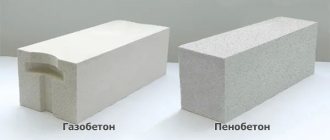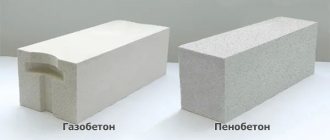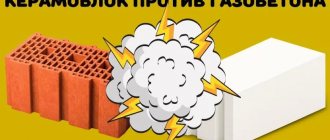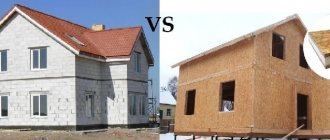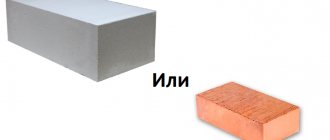Sibit is a piece building material belonging to the class of cellular concrete. Produced by the Glavnovosibirskstroy Group of Companies. It was this type of wall blocks that was the first in Russia to receive a certificate of conformity at the international level GOST R ISO 9001:2000. The peculiarity of the material is complete adaptation to the harsh climate of our country. The blocks are widely used for the construction of residential buildings and industrial facilities in Siberia, Transbaikalia, and the Far North. In central Russia, this type of aerated concrete is also called Baikal or Siberian aerated concrete.
Characteristics of Sibit aerated concrete
Current manufacturers of building materials offer many different aerated concretes to customers. Among them is the aerated concrete mixture Sibit, which is one of the most popular in construction. All thanks to its quality, a lot of advantages, positive characteristics, excellent “behavior” during operation. What is this type of aerated concrete? Let's find out.
Components
To make high-quality blocks from sibit aerated concrete, you must first prepare a mixture of a porous structure from pre-crushed components: cement, lime, aluminum powder, sand, water. When the solution is ready, massive monoliths are formed from it, which, after hardening, are cut into blocks of the required size.
Then the aerated concrete will have to be processed under high pressure inside an autoclave oven. This process is necessary in order to provide the finished product with maximum strength and other positive properties.
ARS 22
Today, you won’t surprise anyone with a luxurious house made of aerated concrete or Betolex, although previously it was believed that blocks made of cellular concrete were more suitable for the construction of outbuildings and country houses.
But the advantages of the material were quickly appreciated by professionals, and the technology for producing blocks is constantly being improved. Therefore, today architects offer interesting designs for houses made of betolex, sibit, and aerated concrete, which are not inferior in functionality and design to brick buildings. Cellular concrete is easy to process, so it can be used for the construction of houses and cottages of various designs, as well as for the construction of utility blocks, garages, arched structures, etc.
We have been engaged in low-rise construction in Barnaul since 2000; Sibit, Betolex, and aerated concrete are well known to us. Therefore, we will try to explain how these building materials differ, what are the pros and cons of houses made of aerated concrete, and also touch upon the issue of the cost of such turnkey housing.
What is the difference between Sibit, Betolex, foam concrete and aerated concrete?
It’s easy for even an experienced builder to get lost in concepts. Sibit and Betolex are the commercial names for building blocks. Both Sibit and Betolex are classified as autoclaved aerated concrete. Both the chemical composition and strength characteristics are the same. Autoclaved aerated concrete produced by the Barnaul Cellular Concrete Plant (ZYB) also belongs to this category of blocks. Commercial name "Bagit". All other aerated concrete, foam concrete, etc. It is produced without steaming chambers and is not autoclave. Such aerated concrete is much inferior in technical characteristics to autoclaved aerated concrete. The geometry of the blocks also suffers, which will naturally lead to additional costs for their installation.
Under the Betolex brand they produce not only building blocks (like Sibit), but also wall panels, lintels, roofing and ceiling structures. An important difference between Betolex and aerated concrete is that the former is laid with a special glue, and not with a solution. The blocks have a perfectly even shape and are equipped with a tongue-and-groove system, which makes building a house easier.
What is the difference between “gas blocks”, “foam blocks” and “twin blocks”?
Sometimes consumers confuse the concepts of “gas block”, “foam block”, “twin block”. In fact, all of this applies to cellular concrete blocks. And blocks made of cellular concrete come in different forms, just like cars or bread.
According to the method of pore formation, they are distinguished:
- aerated concrete. In aerated concrete, the pores are through (hence the concept that “aerated concrete breathes”)
- foam concrete blocks.
According to the method of hardening, blocks are divided into:
- autoclave. Autoclaved aerated concrete is an artificially synthesized stone. As a result, autoclaved aerated concrete has a significantly better geometry, it is warmer, stronger, lighter, more convenient to use, and more environmentally friendly.
- non-autoclave. Non-autoclaved aerated concrete, as well as foam concrete, is actually a cement-sand mortar frozen in a porous state.
During autoclave hardening, aerated concrete is placed in metal capsules (autoclaves), where a temperature of 191 degrees Celsius and a pressure of 12 atmospheres are maintained. In an autoclave, changes occur in the structure of aerated concrete at the molecular level and a new mineral with improved performance characteristics is formed - tobermorite.
There is no autoclaved foam block!
Equipment for the production of autoclaved aerated concrete costs from 2 billion rubles, and for foam concrete or non-autoclaved aerated concrete - from 100,000 rubles. Here's the whole truth for you.
Twinblock and Gasblock are the same thing
“Twinblock” is not a separate type of cellular concrete blocks, but a brand name for autoclaved aerated concrete from. Since this brand of aerated concrete has been widely distributed in the Sverdlovsk region for many years, over time the word “Twinblock” has become a household name. Like a Kamaz or a photocopier.
In the Tyumen region, gas blocks are most often called “Porevit”, and in the Novosibirsk region - “Sibit”.
In total, gas blocks are supplied to the Urals from 9 factories: Teplit, Porevit, Porablok, Betolex, Sibit, Varmit, Insi, Aerorate, Betokam.
Where to buy aerated concrete: at the factory or from a dealer?
At first glance, it seems that it is more logical to buy a gas block from a factory. But with a more careful approach, you can see that this is not the case.
We have prepared for you a comparison table based on customer opinions and our experience.
Dealers/trading companies purchase from factories in large quantities and have discounts. And also more customer-oriented.
Factories from other regions give large discounts to their dealers so that they can supply units to our region and “pass” on the price. For example, the Sibit block costs 4,750 rubles/m3 in Novosibirsk. While in the Sverdlovsk region they already cost 3,050 rubles with free delivery. (data as of November 2016)
We are not saying that it is not worth buying from the factory. We are talking about the fact that you can buy from a dealer/trading company easier, cheaper and with a guarantee against chips and damage.
If you need to purchase several pallets of blocks, we recommend purchasing them at the nearest construction market or asking your neighbors. In this case, you will save significantly on delivery.
Dimensions
And now about the size of the sibit . Dimensions depend on the type of product:
- Wall blocks. They are divided into four different types: B2 has a ratio of 600/200/250, B3 is slightly wider - 300 millimeters, and B4 is already 400 millimeters.
- Blocks for interior walls. There are also three categories here. The smallest sizes are: 625/100/250, the largest are 150 wide, other parameters are unchanged.
- Floors. The length here will vary - from 2 to 6 meters. At the same time, the width is 60 cm, the height is 24 cm. They are very strong, they are not afraid of heavy loads, the maximum load weight is 800 kilograms.
- Jumpers. The longest are 3 places of 10 cm. As for the maximum width and height, these are 30 and 60 cm, respectively.
From 20 to 50 standard blocks are placed on one pallet.
Advantages and properties of sibit products
All the advantages of this material are based on the technical characteristics of Sibit blocks. Their coordinated combination best meets the requirements for products for structural and structural-thermal insulation purposes. For clarity, let’s combine the main properties of sibit and compare them with traditional brick.
A sibit block with a volume of 0.036 m³ weighs 18 kg, and the same volume of bricks (15-20 pieces) weighs up to 80 kg.
Wall thickness (for climatic conditions of Siberia)
The vapor permeability of sibit blocks is 5-6 times higher than that of brick, and is equal to 0.17 g/m. This means that aerated concrete is able to get rid of moisture that has entered it in a short time and ensure normal air conditions in the room.
Today, the construction of houses from sibit in Siberia is very popular; the pros and cons of such construction are worth considering in more detail. First, about the advantages.
- The low thermal conductivity coefficient allows you to significantly save on heating your home. The thermophysical characteristics of sibit enable walls to retain heat indoors, and wall surfaces to be warm when touched.
- The low physical weight of structures made of cellular concrete does not require a powerful foundation for a house made of sibit.
- In terms of strength, sibit products, especially reinforced ones, are quite comparable to ordinary and reinforced concrete.
- The extremely high frost resistance indicates that Sibit is an excellent material for construction in Siberia.
- The use of floor slabs made of Sibit porous concrete means a ready-made insulated attic, saving expensive wood and reducing the cost of one square meter of the house.
- Labor costs in the construction of buildings from sibit are almost one and a half times lower than when using brick. Experienced masons lay 15 m³ of light blocks during one work shift; bricks can make no more than 7 m³. This means that you can build a house from sibit in a shorter time.
It is difficult to find flaws in sibit products, except for its fragility. But this disadvantage can be easily overcome by careful handling of blocks and slabs during transportation, rigging and any movements.
Laying sibit blocks
Working with sibit blocks is not much different from ordinary bricklaying or other block products. That is, precise placement of corners and special attention to the first row, constant control of verticality with a plumb line and horizontality with a spirit level. It’s good if you have the opportunity to use a laser level. But there are still some nuances.
- The blocks can be easily processed with the simplest tools. They can be sawed, cut, planed, that is, all the necessary additional elements can be prepared at the construction site.
- For masonry, it is recommended to use special sibit glue. It will ensure reliable adhesion of the blocks to each other. Although the first row of foundation waterproofing can also be laid on masonry cement-sand mortar.
- The external and internal surfaces of the walls of the building should be covered with finishing materials.
- To decorate door and window openings from above, it is advisable to use reinforced sibit lintels.
Products made from cellular concrete are lightweight, durable and reliable. However, wall cabinets do not hold up well on porous walls. When arranging furniture and decorating rooms, you must use fasteners specifically designed for porous surfaces.
When choosing a sibit
As the main material for the walls
of a house,
one should not forget that sibit, like any other material, has its
pros and cons
. Let's first touch on its positive characteristics.
Firstly, sibit has excellent sound and heat insulation, the second is worth mentioning separately. The thermal conductivity of sibit is approximately four times lower than that of brick, that is, a house made of sibit retains heat 4 times better in winter, as well as comfortable coolness in hot weather, since the material “breathes” like wood. The material has these properties due to its porous structure; as a result of the excellent thermal insulation, sibit will allow you to significantly save on heating.
Sibit houses are environmentally friendly houses. No toxic substances are used in this production of this wonderful material. Sibit is created on the basis of only natural mineral substances, which are also insoluble in water. The material does not burn.
Sibit is a very convenient and pliable material: thanks to its lightness and ease of processing, installation and transportation of the material will cost less than when building with bricks for building a house from Sibit
no crane or similar equipment is needed. In addition, when designing, a much smaller load is taken into account, and this also saves on the amount of concrete. Sibit is easy to saw and nails can be driven into it.
Main disadvantage
sibita lies in its low strength, in comparison with brick and concrete. It is not advisable to hang heavy metal brackets on sibit walls, massive cabinets, water heaters and hunting trophies; for this purpose, special reinforcing structures should be built from angle iron.
The remaining disadvantages are not so critical for private housing construction:
- You should not build houses from sibit without a frame of more than five floors.
- Sibit requires interior and exterior finishing.
- Some skeptics still argue that sibit absorbs moisture over time and cracks due to the presence of open pores. (Just use a moisture-proof finish in damp areas.)
- Again, some skeptics argue that the lime contained in the material is harmful. Well, even the resins contained in the most environmentally friendly wood are also harmful to some extent.
How does Sibit aerated concrete differ from other types of lightweight concrete?
Cellular or lightweight concrete is divided into several main types:
- Aerated concrete;
- Foam concrete;
- Gas foam concrete.
They are also divided into two types according to the manufacturing method, they are:
- Autoclave - a distinctive feature of the technology is the drying of products in an autoclave oven, where, under the influence of high temperature, the blocks receive improved strength and resistance to external influences.
- Non-autoclaved - blocks harden under natural conditions.
So what is the difference between Sibit and foam concrete? Let's look at the main differences.
Firstly, Sibit is manufactured using an autoclave method, so its strength indicators are much higher than those of foam blocks. This allows the use of aerated concrete for the construction of multi-story buildings.
For the construction of buildings above three floors, aerated concrete with a density grade of D1200 is used.
Secondly, Sibita blocks have a flat surface and straight lines, which allows you to save on adhesive solution when laying, due to the tight fit of the blocks to each other.
In other respects, the materials are equal to each other, so when choosing between Sibit or foam block, you should take into account your own preferences, cost and purpose of use.
Areas of use
The advantage of a house built from SIBIT is that heating it will require significantly less energy.
Sibit aerated concrete is a unique material. Its use is practiced in almost all construction industries. These types of blocks are mainly used for:
- construction of private estates of various sizes;
- construction of buildings for economic purposes;
- construction of massive industrial structures;
- masonry of interior walls;
- insulation of facades if the building itself is constructed from a different building material;
- the formation of door and window openings.
Autoclaved aerated concrete – SIBIT
These blocks are very easy to use, which increases the speed of construction. Sibit has excellent technical characteristics and is not subject to any climatic influences.
Price: 7100 rub./m3
Trading house SibTrans is a dealer of the SIBIT plant in Tomsk and maintenance.
After paying for the goods, you can leave all materials in our warehouse and pick them up at any time!
Buying now, you get:
- fixed prices for SIBIT at the time of purchase;
- free storage of your building materials;
- shipment of the order at any time convenient for you.
| Conventional brand | Block dimensions, mm | Blocks per pallet | ||||||||
| length | height | width | ||||||||
| Density grade D500. Concrete class for compressive strength is B 2.5. Frost resistance grade F100. | ||||||||||
| B100/625 D500 B2.5 | 625 | 250 | 100 | 48 | ||||||
| B200/625 D500 B2.5 | 625 | 250 | 200 | 24 | ||||||
| B300/625 D500 B2.5 | 625 | 250 | 300 | 16 | ||||||
| B400/625 D500 B2.5 | 625 | 250 | 400 | 12 | ||||||
| Density grade D600. Concrete class for compressive strength is B 2.5. Frost resistance grade F100. | ||||||||||
| B100/625 D600 B2.5 | 625 | 250 | 100 | 48 | ||||||
| B200/625 D600 B2.5 | 625 | 250 | 200 | 24 | ||||||
| B300/625 D600 B2.5 | 625 | 250 | 300 | 16 | ||||||
| B400/625 D600 B2.5 | 625 | 250 | 400 | 12 | ||||||
| Volume of 1 pallet = 0.75 cubic meters. m Dimensions of a pallet with SIBIT products (h*b*l) = 1000 mm * 625 mm * 1.305 mm Weight of a pallet with SIBIT blocks with density D500 = up to 490 kg, with SIBIT blocks with density D600 = up to 580 kg. The weight of blocks and pallets is indicated for a release humidity of 25% | ||||||||||
How is Betolex made?
According to its principle, the production of betolex occurs in the same way as the production of sibit. Betolex is an autoclaved concrete that has a cellular structure. This is a stone created artificially, the plane of which is completely permeated with pores. The material hardens in an autoclave under the influence of steam at high pressure. The result is a very porous material, which, in its characteristics, is very similar to wood. It should be noted that not a single building material that is produced using a non-autoclave method can surpass the benefits of Betolex.
The technology for producing such a building material as sibit was discovered at the beginning of the 20th century by the Swedish scientist A. Ericsson. Sibit is an artificial stone in which the pores are evenly distributed. Thanks to this structure, this material has many positive physical and mechanical properties.
Sibit blocks - technical characteristics:
1 . Wall mass
. The mass of a wall made of sibit blocks (if calculated per square meter) is 4 - 5 times less than the mass of bricks. Therefore, you can save approximately 10 - 15% during the construction of a particular building. A typical sibit block weighs about 18 kilograms and has dimensions of 20*25*60 cm.
2 . Wall thickness.
When compared with brick, the thickness of sibit blocks will be 2 times less than that of brick. According to the requirements of the international standard of technical specifications, the thickness of sibit walls should not be less than 60 centimeters.
3 . Thermal conductivity
. The thermal conductivity coefficient of sibit is 0.16 W/mK. This figure is four times less than that of brick. But at the same time, sibit’s thermal conductivity allows it to retain heat in the house at a high level.
4 . Vapor permeability.
The vapor permeability of sibit blocks is 0.17 g/m and thus ensures the rapid removal of moisture from the material, which may occur over time. The level of vapor permeability allows you to maintain a pleasant atmosphere in the house and is always in fresh air.
5. Frost resistance
. The level of frost resistance of sibit is at an incredibly high level. Since, according to the state standard, a building material must withstand at least 35 freezing cycles, and Sibit can easily withstand as many as 200 cycles. This is explained by the ego's unique porosity.
6 . Floor slabs.
The strength of sibit block floors is about 800 kilograms. If you cover the roof with sibit, then the attic will be so warm that you can live there calmly.
7. Material and labor costs. Compared to brick, the labor costs for working with sibit are much less. This is primarily because sibit blocks are much larger in volume than bricks. When working on construction, sibit is also good because it can be easily processed with various building materials.
In one shift, an average team of workers is quite capable of laying 7 cubic meters of sibithu wall.
For example, an ordinary country house with an area of 250 square meters can be completed by a team of 5 people within 40 days.
Production technology
Technologies for the production of such aerated concrete are distinguished by the use of boiling lime, which is used to bind other ingredients.
Also, the required amount of cement sand is mixed into the solution. All manipulations using crushed quicklime are carried out automatically inside tightly sealed containers and transport lines. This technique is needed to minimize the interaction of lime with air. Otherwise, the quenching period may occur earlier than expected, which may lead to impaired swelling of the solution. These actions allow us to produce products of improved quality. The porosity of aerated concrete is achieved by mixing aluminum powder into the solution. After interacting with calcium oxide hydrate for about a minute, aluminum powder begins to transform into a porous substance.
Product range
Sibit aerated concrete blocks are in great demand; they can be divided into three main types:
- Structural - used for the construction of load-bearing structures and floor slabs. They have high strength indicators, the density of these blocks is D900 - D1200;
- Thermal insulation - used for additional insulation of walls, or the construction of structures on which there is no heavy load, the density of the thermal insulation block is from D400 to D500;
- Structural and thermal insulation products - have all the advantages of the varieties described above; the use of these blocks in the construction of external walls of a residential building will allow you to save on additional insulation.

